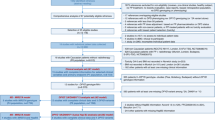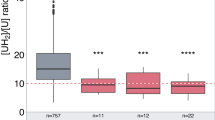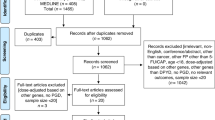Abstract
5-Fluorouracil is among the most widely used anticancer drug, but a fraction of treated patients develop severe toxicity, with potentially lethal injuries. The predictive power of the available pretreatment assays, used to identify patients at risk of severe toxicity, needs improvements. This study aimed to correlate a phenotypic marker of 5-fluorouracil metabolism (the individual degradation rate of 5-fluorouracil—5-FUDR) with 15 functional polymorphisms in the dihydropyrimidine dehydrogenase gene (DPYD). Single SNP (single-nucleotide polymorphism) analysis revealed that the SNPs rs1801160, rs1801265, rs2297595 and rs3918290 (splice site variant IVS14+1G>A) were significantly associated with a decreased value of 5-FUDR, and the rs3918290 causing the larger decrease. Multi-SNP analysis showed that a three-SNP haplotype (Hap7) involving rs1801160, rs1801265 and rs2297595 causes a marked decrease in 5-FUDR, comparable to that caused by the splice site variant rs3918290, which is the main pharmacogenetic marker associated with severe fluorouracil toxicity. The similar effect played by Hap7 and by the splice site variant rs3918290 upon individual 5-FUDR suggests that Hap7 could also represent a similar determinant of fluorouracil toxicity. Haplotype assessment could improve the predictive value of DPYD genetic markers aimed at the pre-emptive identification of patients at risk of severe 5-fluorouracil toxicity.
This is a preview of subscription content, access via your institution
Access options
Subscribe to this journal
Receive 6 print issues and online access
$259.00 per year
only $43.17 per issue
Buy this article
- Purchase on Springer Link
- Instant access to full article PDF
Prices may be subject to local taxes which are calculated during checkout
Similar content being viewed by others
References
Longley DB, Harkin DP, Johnston PG . 5-fluorouracil: mechanisms of action and clinical strategies. Nat Rev Cancer 2003; 3: 330–338.
Diasio RB, Beavers TL, Carpenter JT . Familial deficiency of dihydropyrimidine dehydrogenase. Biochemical basis for familial pyrimidinemia and severe 5-fluorouracil-induced toxicity. J Clin Invest 1988; 81: 47–51.
Harris BE, Carpenter JT, Diasio RB . Severe 5-fluorouracil toxicity secondary to dihydropyrimidine dehydrogenase deficiency. A potentially more common pharmacogenetic syndrome. Cancer 1991; 68: 499–501.
Lyss AP, Lilenbaum RC, Harries BE, Diasio RB . Severe 5-fluorouracil toxicity in a patient with decreased dihydropyrimidine dehydrogenase activity. Cancer Invest 1993; 11: 239–240.
van Staveren MC, Guchelaar HJ, van Kuilenburg AB, Gelderblom H, Maring JG . Evaluation of predictive tests for screening for dihydropyrimidine dehydrogenase deficiency. Pharmacogenom J 2013; 13: 389–395.
Schwab M, Zanger UM, Marx C, Schaeffeler E, Klein K, Dippon J et al. German 5-FU Toxicity Study Group. Role of genetic and nongenetic factors for fluorouracil treatment-related severe toxicity: a prospective clinical trial by the German 5-FU Toxicity Study Group. J Clin Oncol 2008; 26: 2131–2138.
Offer SM, Wegner NJ, Fossum C, Wang K, Diasio RB . Phenotypic profiling of DPYD variations relevant to 5-fluorouracil sensitivity using real-time cellular analysis and in vitro measurement of enzyme activity. Cancer Res 2013; 73: 1958–1968.
Offer SM, Fossum CC, Wegner NJ, Stuflesser AJ, Butterfield GL, Diasio RB . Comparative functional analysis of DPYD variants of potential clinical relevance to dihydropyrimidine dehydrogenase activity. Cancer Res 2014; 74: 2545–2554.
Caudle KE, Thorn CF, Klein TE, Swen JJ, McLeod HL, Diasio RB, Schwab M . Clinical Pharmacogenetics Implementation Consortium guidelines for dihydropyrimidine dehydrogenase genotype and fluoropyrimidine dosing. Clin Pharmacol Ther 2013; 94: 640–645.
Cross DS, Ivacic LC, Stefanski EL, McCarty CA . Population based allele frequencies of disease associated polymorphisms in the Personalized Medicine Research Project. BMC Genet 2010; 11: 51.
Lee AM, Diasio RB . Genetic biomarkers for Fluorouracil toxicity prediction: the long road to clinical utility. J Clin Oncol 2014; 32: 989–990.
Lostia AM, Lionetto L, Ialongo C, Gentile G, Viterbo A, Malaguti P et al. A liquid chromatography-tandem mass spectrometry method for the determination of 5-fluorouracil degradation rate by intact peripheral blood mononuclear cells. Ther Drug Monit 2009; 31: 482–488.
SNPStats software. http://bioinfo.iconcologia.net/SNPstats Last accessed 11 November 2014.
Solé X, Guinó E, Valls J, Iniesta R, Moreno V . SNPStats: a web tool for the analysis of association studies. Bioinformatics 2006; 22: 1928–1929.
Rosmarin D, Palles C, Church D, Domingo E, Jones A, Johnstone E et al. Genetic markers of toxicity from capecitabine and other fluorouracil-based regimens: investigation in the QUASAR2 study, systematic review, and meta-analysis. J Clin Oncol 2014; 32: 1031–1039.
Morel A, Boisdron-Celle M, Fey L, Soulie P, Craipeau MC, Traore S et al. Clinical relevance of different dihydropyrimidine dehydrogenase gene single nucleotide polymorphisms on 5-fluorouracil tolerance. Mol Cancer Ther 2006; 5: 2895–2904.
van Kuilenburg AB, Haasjes J, Richel DJ, Zoetekouw L, Van Lenthe H, De Abreu RA et al. Clinical implications of dihydropyrimidine dehydrogenase (DPD) deficiency in patients with severe 5-fluorouracil-associated toxicity: identification of new mutations in the DPD gene. Clin Cancer Res 2000; 6: 4705–4712.
Gross E, Ullrich T, Seck K, Mueller V, de Wit M, von Schilling C et al. Detailed analysis of five mutations in dihydropyrimidine dehydrogenase detected in cancer patients with 5-fluorouracil-related side effects. Hum Mutat 2003; 22: 498.
Deenen MJ, Tol J, Burylo AM, Doodeman VD, de Boer A, Vincent A et al. Relationship between single nucleotide polymorphisms and haplotypes in DPYD and toxicity and efficacy of capecitabine in advanced colorectal cancer. Clin Cancer Res 2011; 17: 3455–3468.
Baskin Y, Amirfallah A, Unal OU, Calibasi G, Oztop I . Dihydropyrimidine dehydrogenase 85T>C mutation is associated with ocular toxicity of 5-fluorouracil: a case report. Am J Ther 2015; 22: e36–e39.
Gross E, Busse B, Riemenschneider M, Neubauer S, Seck K, Klein HG et al. Strong association of a common dihydropyrimidine dehydrogenase gene polymorphism with fluoropyrimidine-related toxicity in cancer patients. PLoS One 2008; 3: e4003.
van Kuilenburg AB, Häusler P, Schalhorn A, Tanck MW, Proost JH, Terborg C et al. Evaluation of 5-fluorouracil pharmacokinetics in cancer patients with a c.1905+1G>A mutation in DPYD by means of a Bayesian limited sampling strategy. Clin Pharmacokinet 2012; 51: 163–174.
Wei X, McLeod HL, McMurrough J, Gonzalez FJ, Fernandez-Salguero P . Molecular basis of the human dihydropyrimidine dehydrogenase deficiency and 5-fluorouracil toxicity. J Clin Invest 1996; 98: 610–615.
Offer SM, Lee AM, Mattison LK, Fossum C, Wegner NJ, Diasio RB . A DPYD variant (Y186C) in individuals of African ancestry associated with reduced DPD enzyme activity. Clin Pharmacol Ther 2013; 94: 158–166.
Kouwaki M, Hamajima N, Sumi S, Nonaka M, Sasaki M, Dobashi K et al. Identification of novel mutations in the dihydropyrimidine dehydrogenase gene in a Japanese patient with 5-fluorouracil toxicity. Clin Cancer Res 1998; 4: 2999–3004.
Acknowledgements
This paper is dedicated to the memory of our wonderful teacher and friend, Professor Donatella Barra, who recently passed away.
Author information
Authors and Affiliations
Corresponding author
Ethics declarations
Competing interests
The authors declare no conflict of interest.
Rights and permissions
About this article
Cite this article
Gentile, G., Botticelli, A., Lionetto, L. et al. Genotype–phenotype correlations in 5-fluorouracil metabolism: a candidate DPYD haplotype to improve toxicity prediction. Pharmacogenomics J 16, 320–325 (2016). https://doi.org/10.1038/tpj.2015.56
Received:
Revised:
Accepted:
Published:
Issue Date:
DOI: https://doi.org/10.1038/tpj.2015.56
This article is cited by
-
Effect of drug metabolizing enzymes and transporters in Thai colorectal cancer patients treated with irinotecan-based chemotherapy
Scientific Reports (2020)
-
The clinical relevance of multiple DPYD polymorphisms on patients candidate for fluoropyrimidine based-chemotherapy. An Italian case-control study
British Journal of Cancer (2019)
-
Examination of multiple UGT1A and DPYD polymorphisms has limited ability to predict the toxicity and efficacy of metastatic colorectal cancer treated with irinotecan-based chemotherapy: a retrospective analysis
BMC Cancer (2017)
-
Dihydropyrimidine dehydrogenase pharmacogenetics for predicting fluoropyrimidine-related toxicity in the randomised, phase III adjuvant TOSCA trial in high-risk colon cancer patients
British Journal of Cancer (2017)



